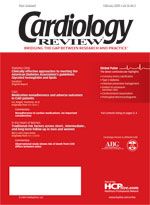Novel approaches to rhythm control in atrial fibrillation: The role of inhibition of the renin-angiotensin system
Atrial fibrillation (AF) is the most common arrhythmia, accounting for approximately one third of all patient discharges with arrhythmia as the principal diagnosis and the greatest number of hospitalization days for arrhythmia each year.
Atrial fibrillation (AF) is the most common arrhythmia, accounting for approximately one third of all patient discharges with arrhythmia as the principal diagnosis and the greatest number of hospitalization days for arrhythmia each year.1 In the landmark AFFIRM trial, patients with AF were randomized to 2 different treatment strategies: control of the ventricular rate with AV nodal blocking agents (rate control), or maintenance of sinus rhythm with anti-arrhythmic drugs (rhythm control).2 Many cardiologists had assumed that rhythm control would be superior, since restoration of sinus rhythm was expected to reduce the increased rates of stroke and death that have been associated with AF. Surprisingly, the rhythm control strategy was associated with a trend towards increased mortality in AF patients. In a subsequent analysis of the AFFIRM data, the presence of sinus rhythm was associated with decreased mortality, and treatment with anti-arrhythmic drugs was associated with increased mortality.3 These findings suggest that maintenance of sinus rhythm may still be desirable in AF patients; however, more effective and less toxic therapies are needed to achieve this goal. To this end, there has been increasing interest in the potential role of angiotensin-converting enzyme (ACE) inhibitors or angiotensin-receptor blockers (ARBs) for preventing AF in selected patients.
An extensive body of evidence has validated the use of ACE inhibitors and ARBs for patients with diabetes, hypertension, recent myocardial infarction, and left ventricular dysfunction.4-7 Secondary analyses of some of these studies have suggested that ACE inhibitors are associated with a decreased incidence of AF.8 The mechanism of the potential benefit of these drugs in AF may be decreased electrical and structural remodeling of the atria.9 In a recent meta-analysis, Healey et al reported that ACE inhibitors and ARBs reduced the relative risk of AF by 28%, with no significant difference noted between the 2 classes of drugs.10 The benefit was greatest in patients with heart failure, with no difference noted in patients with hypertension. These findings are unlikely to change current clinical practice, since patients with heart failure should already receive an ACE inhibitor or ARB unless there is a compelling contraindication. Many AF patients have hypertension without concomitant heart failure, or “lone AF” without stroke risk factors. If ACE inhibitors or ARBs had demonstrated efficacy for preventing AF in such patients, then they could be used for rhythm control in lone AF and the presence of AF could become another factor to consider when selecting an antihypertensive agent.
Limited evidence suggests that the addition of an ACE inhibitor or ARB to amiodarone may increase the efficacy of rhythm control after cardioversion.11 In the present study by Yin et al (originally in reference 12), patients with lone paroxysmal AF were randomized to 1 of 3 treatment strategies: amiodarone alone, amiodarone + losartan, or amiodarone + perindopril. The incidence of subsequent AF was significantly reduced in subjects that received an ACE inhibitor or ARB. Unfortunately, this study suffers from several design flaws that limit the applicability and importance of its conclusions. The study drugs were administered in a nonrandomized, open-label fashion, which violates some of the most basic tenets of clinical trial design. Since the patients and the physicians were aware of the treatment assignments, this could importantly impact on the ability to detect and document AF. Furthermore, the primary endpoint for the study, the incidence of AF, is subject to important detection bias, since many patients with AF are unaware of some or all of their AF episodes.13 Continuous event monitors with algorithms to automatically detect AF have been developed to address this problem, but they were not employed in the present study. Finally, this study was underpowered to detect any difference in efficacy between ACE inhibitors and ARBs.
Should patients with hypertension and AF or lone AF be prescribed an ACE inhibitor or ARB to help maintain sinus rhythm? At present, there is insufficient evidence to routinely recommend this strategy. Most previous studies have evaluated the addition of an ACE inhibitor or ARB to amiodarone, and it is unclear whether the addition of these agents would offset the adverse prognosis associated with anti-arrhythmic drugs in AFFIRM, even if the efficacy of rhythm control is enhanced. For this reason, ACE inhibitors or ARBs would be most useful if they had demonstrated efficacy as monotherapy to achieve rhythm control in AF. To this end, secondary analyses of clinical trials that were designed for another purpose are useful for generating a hypothesis, but they cannot be used to justify a change in clinical practice. Properly designed, prospective, placebo-controlled randomized clinical trials are required to establish the role of ACE inhibitors and ARBs in AF management.
